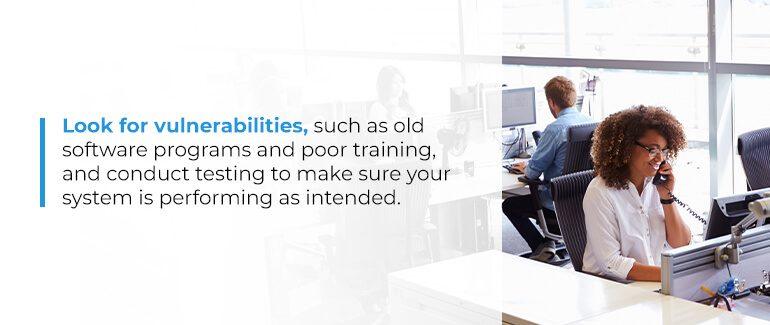How to Create an Information Security Plan
An information security plan is a critical part of any financial services firm’s approach to cybersecurity. Information security plans can vary widely, but share the common goal of outlining data handling practices. Depending on the size and maturity of your business, your information security plan could be quite detailed. To make things easier, we’ve created a comprehensive guide to creating an IT security plan for your organization.
What Is an Information Security Plan?
At its core, an information security plan is a set of policies and procedures that govern how data is handled in your business. It could range from relaxed, general guidelines to strictly enforced policies necessary for high levels of regulation, such as those in the financial sector. Factors to address in this kind of plan include what security measures are in place for personally identifiable information (PII) and how your firm plans to respond to breach incidents.
Why Is an Information Security Plan Important?
These plans are nothing short of critical. For many, they’re a necessary part of showing compliance with industry regulations, such as those from the U.S. Securities and Exchange Commission (SEC). In addition to supporting your security and compliance efforts, an IT security plan can be beneficial to the overall success of your organization.
An information security plan ultimately benefits an organization by helping prevent the exposure, loss or corruption of data. Firms can also benefit from efficiency improvements that avoid data corruption, reputational benefits through avoiding the bad press of a data breach, and cost benefits from avoiding fines and litigation from noncompliance.
Learn More
Fundamentals of an Information Security Plan
For most security professionals, data privacy and governance make up the primary area of responsibility. In addition, most information security plans address these three components:
- Screening: Screening people who have access to your firm’s data reduces the risk that they will use it maliciously or unknowingly create issues. Look for prior security problems and previous records during the hiring process.
- Assets: To accurately determine the security risk associated with corporate data and develop appropriate handling policies, information needs to be organized and categorized.
- Policy: Developing a companywide policy helps create an overarching strategy and a core for the IT security strategy.
Steps to Create an Information Security Plan
When creating your information security plan, follow these steps to make sure it’s comprehensive and meets your firm’s needs:
1. Form a Security Team
The first step is to build your A-team. Get a group together that’s dedicated to information security. They’ll be in charge of creating and enforcing your policy, responding to an evolving landscape of cybersecurity threats, determining risk thresholds and even organizing funding. Make sure this team knows their stuff.
2. Assess System Security Risks, Threats and Vulnerabilities

Get the lay of the land by evaluating where your current system is potentially exposed to threats. Look for vulnerabilities, such as old software programs and poor training, and conduct testing to make sure your system is performing as intended.
3. Identify Current Safeguards
Measure how well your current system is protecting your data and your clients’ data and what options you might have available. Safeguards might include security features in your business software, physical security such as gated entrances and procedural measures like having representatives log out when leaving a computer.
4. Perform Cyber Risk Assessment
Assess how cybersecurity problems and breaches would affect your organization. Would a breach bring operations to a halt? Would it entail damage control? And what about regulatory fines? Identify what factors are associated with the cybersecurity risks facing your firm.
5. Perform Third-Party Risk Assessment
While it’s critical to watch internal risk, third-party vendors can also pose threats. Revisit them at least annually to check that their policies and practices are in line with your information security plan. Consider making a list of criteria that potential partners need to meet before working with your organization. This list should include the basics like System and Organization Controls (SOC) II compliance.
6. Classify and Manage Data Assets
You can’t protect your assets if you don’t know what you have. Identify your assets and categorize them based on factors like vulnerability, access and storage requirements. This information is necessary for writing policies and procedures that take the relative risk and handling needs of different assets into account.
7. Identify Applicable Regulatory Standards
Financial organizations need to abide bystrict regulations imposed by the SEC. These include robust documentation requirements and various strategies for protecting client confidentiality and risk. Examine these regulations and identify what applies to your organization. You may also want to consider the requests of your stakeholders.
8. Create a Compliance Strategy
After identifying regulation needs, you’ll need a plan to achieve compliance. Outline how you’ll meet regulatory requirements and collect all the necessary documentation.
9. Develop Incident Management and Disaster Recovery Programs
Once you’ve compiled your needs and risks, start creating your response plan. Outline the process carefully, so your team can calmly and systematically address cybersecurity breaches when they occur. Be sure to include various departments, third parties and clients in your plan so everyone can do what they need to do to address the breach.
10. Train and Test Employees
Employees can be a huge asset in the fight against cyberthreats, but they can also be a threat if not well-trained. Set up ongoing training and test employees regularly to make sure they know what to look for.
Tips for Building a Strong Information Security Policy
Keep the following tips in mind when creating your information security plan:
- Conduct regular assessments and testing: You want to know how your system will respond in the event of a security threat. Assess your security system’s performance regularly to ensure it is working appropriately.
- Perform risk remediation: Risk remediation involves identifying potential threats, ideally with extensive visibility. Keep a close eye on new threats in the industry and changes to third-party and internal infrastructures.
- Ramp up training: If your employees don’t know what a scam email looks like or how to appropriately secure their digital information, they could be leaving your organization wide open. With regular training, you can minimize these risks.
- Update hardware and software: Outdated hardware and software can quickly become vulnerable to developments in cybersecurity.
- Limit employee access: Only those who need to access data should be allowed to reach it. This prevents accidental and malicious handling.
- Employ physical security procedures: We spend a lot of time focused on remote access measures, but it’s key to consider physical threats, too. Evaluate and protect the physical security of your servers, data and other assets.
Learn More About Information Security Plans With Agio
If your information security plan needs some work or is nonexistent, Agio can help. Your expertise is in handling money, ours is in ensuring your technology is an enabler, not an inhibitor. the expertise necessary to help you implement and maintain your IT security plan. Between our services for detection and response, consulting, risk management and more, we can assist with every part of the process.
To learn more about our security plans, get in touch with us today.
Share post
Featured Posts
Connect with us.
Need a solution? Want to partner with us? Please complete the fields below to connect with a member of our team.



